The AMD Radeon R7 265 & R7 260 Review: Feat Sapphire & Asus
by Ryan Smith on February 13, 2014 8:00 AM ESTCompute
Jumping into compute, we’re once again treading into familar territory. Pitcairn and Bonaire are Pitcairn and Bonaire, so this will result in the same general performance differences we've seen elsewhere.
As always we'll start with our DirectCompute game example, Civilization V, which uses DirectCompute to decompress textures on the fly. Civ V includes a sub-benchmark that exclusively tests the speed of their texture decompression algorithm by repeatedly decompressing the textures required for one of the game’s leader scenes. While DirectCompute is used in many games, this is one of the only games with a benchmark that can isolate the use of DirectCompute and its resulting performance.
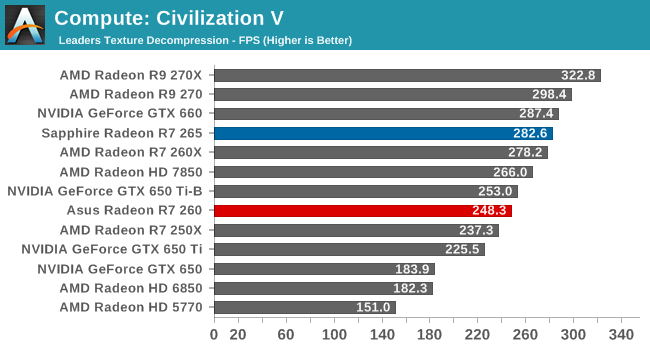
Similar to the 3DMark pixel throughput test on the last page, the Civilization V texture decompression tests highlights the fact that the R7 265 and R7 260X are closer than one would expect in certain edge cases. Once again the R7 260X’s higher clockspeed is helping it keep the gap between it and the R7 265 very narrow, as the two have very similar shader throughput in the end.

The story is much the same with LuxMark as it was Civilization V, with AMD cards once again being sorted almost exactly by shader throughput. Though it’s worth pointing out that NVIDIA’s performance under LuxMark has greatly improved as of the R334 drivers. It’s not enough to close the gap with AMD, but it’s closer than it once was.

Like LuxMark, Sony Vegas is a benchmark dominated by AMD. The lead here is so great that the R7 265 could run this benchmark twice over before the GTX 660 completed it once. Nor would the R7 260 be too far behind in that respect.
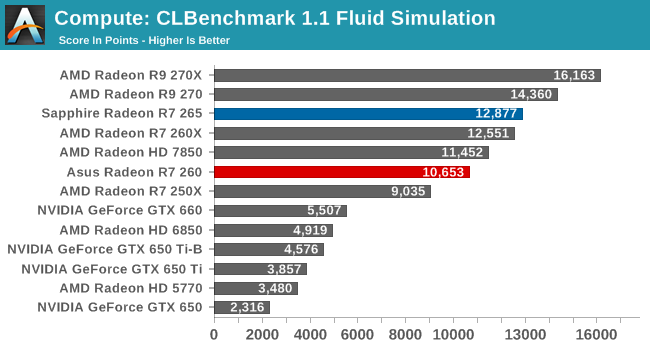

Both CLBenchmark’s fluid simulation benchmark and the computer vision benchmark go to AMD here. The GTX 650 Ti and GTX 660 are not competitive here.
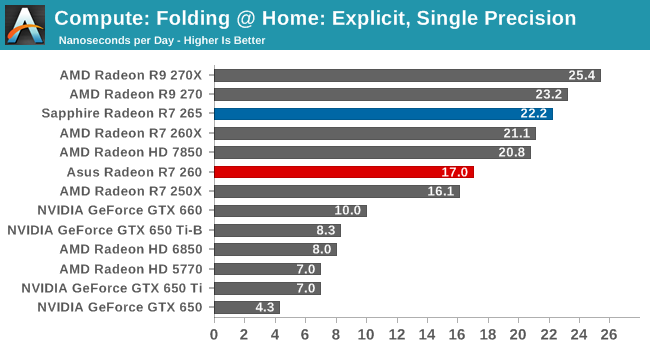
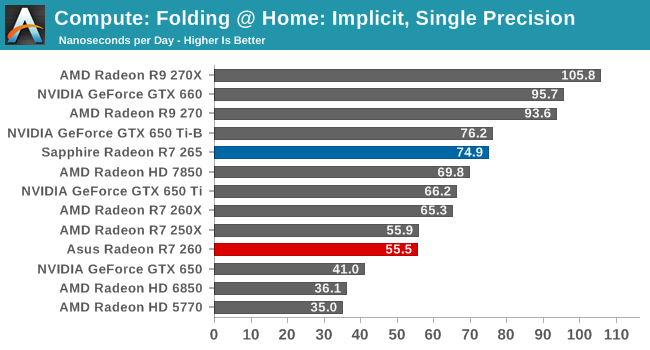
With AMD’s Catalyst 14.1 drivers, AMD has been able to increase their Folding @ Home performance by several percent, closing some gaps while widening others. In the Explicit SP benchmark AMD further increases their lead here, with even the lowly R7 250X holding a significant lead over the GTX 660. On the other hand the R7 265 can’t come close to the GTX 660 under Implicit SP; there’s a lack of raw shader throughput to make it happen.
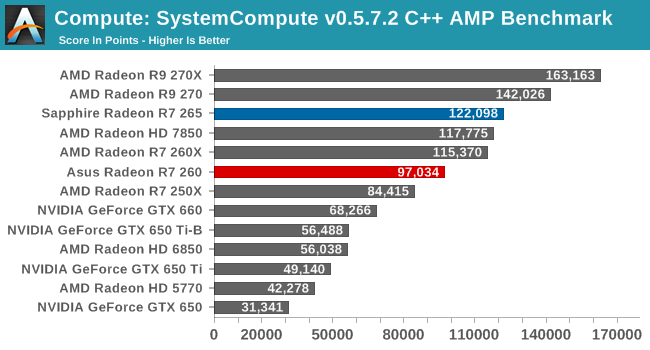
SystemCompute is another compute benchmark that goes to AMD. The R7 265 and R7 260 handily beat the GTX 660, never mind the GTX 650 Ti.










52 Comments
View All Comments
edzieba - Thursday, February 13, 2014 - link
Are Anandtech considering a switch from average framerates to latency/frame-rating (either with Fraps or FCAT)?Ryan Smith - Thursday, February 13, 2014 - link
Frame pacing is an additional tool we run from time to time as is appropriate, but it's not something we'll use for every review. Frame pacing is largely influenced by drivers and hardware, neither of which shift much on a review-by-review basis. So it's primarily reserved for multi-GPU articles and new architectures as appropriate.And especially in the case of single-GPU setups, there's not much to look at. None of these cards has trouble delivering frames at a reasonably smooth pace.
http://www.anandtech.com/bench/GPU14/873
HisDivineOrder - Thursday, February 13, 2014 - link
Yeah, that's what you guys said before the whole frame latency thing broke, too. It's a shame you aren't doing proper monitoring to catch it the first time and are setting up a scenario where it flies under the radar yet again the next time AMD decides to get lax on making drivers.Then again, this article is in red, right? AMD News is right next to it. Hell, even the comment button is red. I'm guessing the AMD overlords wouldn't like it very much if you were constantly harping on something they dropped the ball on so completely that their competitor had to slowly explain to them how to even see the problem and then how to fix it.
gdansk - Thursday, February 13, 2014 - link
It's a shame. I'm with your argument. AnandTech should try to include as many indicative benchmarks as possible. At times FCAT is indicative.But sadly, calling someone a shill with only coincidence is no better than libel. You have made an unsubstantiated allegation. It is decidedly unscientific to insult one's professional integrity with mere coincidental insinuations and no evidence. Why would you do that?
Death666Angel - Thursday, February 13, 2014 - link
So they are in the pocket of nVidia, Intel, AMD, Android AND Apple? Wow, those companies must really be idiots then.Gigaplex - Thursday, February 13, 2014 - link
I don't know where you got all the other brands from, but technically yes Ars is in the pockets of AMD. See http://www.anandtech.com/portal/amd - this is sponsored by AMD.Gigaplex - Thursday, February 13, 2014 - link
Bah, AnandTech, not ArsDeath666Angel - Thursday, February 13, 2014 - link
I know _that_. But he is clearly insinuating that their opinions are bought by AMD. And since products from all those companies I listed (who are all competitors) regularly get recommendations, and Anandtech gets then accused of being paid shills, I find it funny that anyone thinks that is true. If they are bought by AMD as suggested, how come they don't come up with a benchmark track that makes AMD CPUs shine? Or how come they slammed the R9 so much for the noise? It's all pretty silly.nader_21007 - Friday, February 14, 2014 - link
It seems that it hurts you how come this site is not biased and doesn't admire every thing Nvidia, like other sites? well you can go read Tom's Hardware, WCCFtech and every other hardware site, and be sure they will satisfy your needs.zodiacsoulmate - Friday, February 14, 2014 - link
Yea, it's like trying to compare samsung to apple again, sure you can say there is no way to compare which one is better hardware considered, the user experience is just not on pair...